

THE SARDINE RUN
Experience the Sardine Run on South Africa’s Wild Coast — a raw, spectacular event where massive shoals of sardines collide with packs of hunting predators and migrating humpback whales in winter.
With 16 years of experience both on and under the water, Animal Ocean offers a true African ocean adventure — far from the tourist trail. Our trips are built for photographers and filmmakers, designed to get you in the right place at the right time to capture real, unscripted moments of ocean wildlife.
If you want to shoot powerful wildlife images and experience the ocean at its wildest, this is where you want to be.
We've worked with the BBC's Blue Planet II, Netflix's Our Planet, and Our Oceans to create iconic Sardine Run sequences — and now we’re offering you the chance to witness it for yourself.
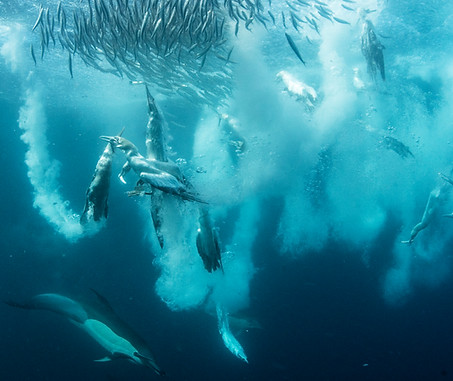

2026 Season SOLD OUT - Look out for 2027 dates coming Feb 2026
DATES and Rates - 2026 Dates
R45 500 - SHARED ROOM | R50 500 PRIVATE ROOM
6 SEA DAYS | 7 Night Package
ADD ON'S
WHATS INCLUDED
-
add SCUBA - R5000 per trip (Advanced divers only)
-
add shuttle from East London to Mdumbi return - R3000 p/p
-
*Private shuttle options available
-
Full snorkeling equipment - R1500 for the 6 day trip.
-
Fully Catered - Breakfast, Boat Snacks, Lunch & Dinner
-
2 Marine guides per vessel (one more than any other operator)
-
Photographic table on the boat
-
Accommodation
-
Basic Wifi. Good for emails and WhatsApp
-
Weights and weight belts
-
1x 10l steel din SCUBA tank on SCUBA option

2026
EXPEDITION - 1
Arrive 11 June - depart 18 June
Boat 1 - Fully Booked
No Boat 2

2026
EXPEDITION - 2
Arrive 19 June - depart 26 June
Boat 1 - Fully Booked
Boat 2 - Fully Booked

2026
EXPEDITION 3
Arrive 14 July - depart 21 July
Boat 1 - Fully Booked
Boat 2 - Fully Booked

2026
EXPEDITION 4
Arrive 22 July - depart 29 July
Boat 1 - Fully Booked
Boat 2 - Fully Booked

Not Included
-
Flights to East London or Mthatha, South Africa.
-
SCUBA supplement
-
Snorkeling equipment - small extra fee for a complete or partial set
-
SCUBA equipment hire - BCD and Regulator
-
Transport to Mdumbi, arranged on request
-
Gratuities
-
Alcohol
Available at Mdumbi
-
Great massages with Lindeka
-
Oysters from the locals
-
East Coast rock lobster from the fishermen
-
Milkshakes, Coffee, and Tea
-
A selection of beer and spirits is available nearby
-
Animal Ocean will have a range of wines available at cost price.
-
Laundry service is available
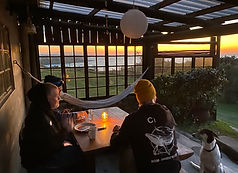
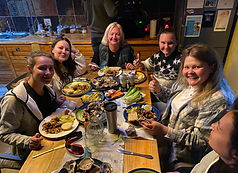
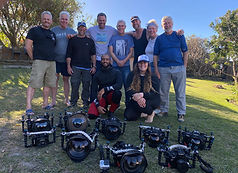
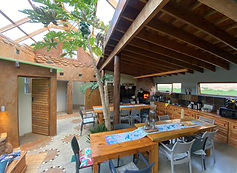
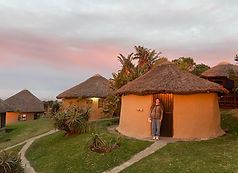
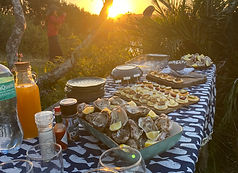
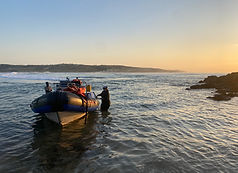
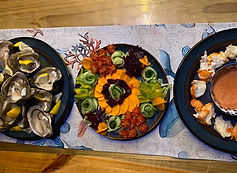
Tourism That Matters
The Sardine Run is more than just a spectacular wildlife event — it’s a vital economic engine for the rural community of Mdumbi. In an area where formal jobs are rare and most families rely on subsistence living, tourism brings real income and opportunity. During the season, over 125 local residents benefit directly — through guiding, seafood sales, craft markets, and support services like shuttles and laundry. The ripple effect is wide, with each earner typically supporting a household of four to six people. Mdumbi Backpackers employs local staff year-round and encourages small business initiatives within the lodge. Tourism here also supports a preschool and a local health clinic. When you visit, you’re not only witnessing the Sardine Run — you’re investing in a community determined to thrive.

Mdumbi - Eastern Cape
We enjoy operating out of Mdumbi because it’s close to the Agulhas Current, which gives us consistently good visibility during the Sardine Run. The strong current and nearby continental shelf drop-off mean that even when rivers are flowing or swell stirs up sediment, the water is often quickly replaced by clean, blue ocean.
We base ourselves at Mdumbi Lodge, where the rolling hills overlook both the estuary and the sea. Each morning, it’s just a short walk down the hill to where we launch the boat — simple, scenic, and right on the doorstep of the action.
We're also one of the few operators working in this area, which keeps the animal activity largely undisturbed. For all these reasons, Mdumbi remains one of our favourite bases for the Sardine Run.
The Daily Routine
Each day begins early, with a candlelit breakfast of omelettes, muesli, fruit, and coffee served from 06:30 AM. After a quick gear-up, guests walk down to beautiful Mdumbi Beach to begin the day’s adventure. By 07:30 AM, we’re through the surf and heading into open ocean — tracking sardines, dolphins, whales, and seabirds along South Africa’s untamed Wild Coast.
The morning launch is gentle and scenic, with the boat launching straight off the sand and into the swell. Once at sea, our experienced crew scans the horizon for signs of life: diving Cape gannets, fast-moving pods of common dolphins, or wheeling seabirds often reveal baitfish and predator activity just below the surface.
We use years of field experience, wildlife behavior knowledge, and observational training to locate action — backed by real-time communication with our spotter pilots and trusted local operators. It’s a dynamic, ever-changing puzzle, and we explore every lead to get you in the right place at the right time.
When we find the action, the crew quickly assesses its nature: if it’s fast-moving, snorkelling is the best approach; if it’s more static, we may switch to scuba. Either way, whether you're in the water or watching from the boat, you’ll have a front-row seat to one of the wildest shows on Earth.
Expect to spend 6 to 8 hours at sea, depending on conditions and activity. The ocean here is raw and unpredictable — long rides, choppy seas, and high-energy encounters are all part of the experience. A reasonable level of fitness and ocean comfort is strongly recommended.
We usually return to shore by 2:00–3:00 PM, though if the action continues, we’ll stay out longer. Afternoons from 4:00 to 6:00 PM are free for rest, journaling, or stretching out. Dinner is served at 6:00 PM, and the day winds down with shared stories and quiet reflection.
Each day on the Sardine Run is a balance of wild encounters and grounding moments — an immersive experience in nature, with space to reconnect to yourself and the ocean.
What To Expect ...
Encountering the ocean in this unique way means being exposed to the water, wind, and sun for the day on the boat (8 hours). Ocean conditions can vary, so those prone to seasickness should bring the necessary preventive medicine. Bring sunscreen, a windbreaker, a hat, sunglasses, and a buff. Mdumbi is a rural village, with no shops or facilities. Bring all your essential items for this time. The evenings can be chilly, and we will be there in the mild South African winter month of June. Temperatures, on land, range from 14-21C in this season. Bring warm clothes for the evenings.
The water temperature ranges from 16C – 22C. We recommend at least a 5mm wetsuit with a hood. Long-blade freediving fins are highly recommended as the action is fast moving and you need to fin to keep up. We provide weights and weight belts with other equipment available to rent if requested.
SCUBA diving is an available option BUT divers must be well trained and comfortable in the water. The conditions are difficult with often poor vis, fast-moving action, big sharks, and open water. We advise that freediving or snorkeling is the better way to experience the Sardine Run as a whole but for some scuba divers, you may want the SCUBA option for photographic purposes. We provide weights, belts and 1 x 10l steel tank. Other equipment can be rented from us if needed.




Accomodation
The rooms you will be staying in are authentic african Xhosa-style round houses, called Rondavels. These are traditional African huts with no en-suit bathrooms. There is electricity in the rooms, but shower and toilet facilities are all located in a central building a short walk away. You can connect to Wifi from most of the rooms, but not all. Wifi is always available in the central dining and reception.
Getting to Mdumbi
To join us, the best options are to fly into either East London Airport or Mthatha Airport. East London is a 6-hour drive from Mdumbi, while Mthatha Airport is only a 2-hour drive away, although it has fewer flight options. Please note that our shuttle and self-drivers must leave East London by 12:00 PM to arrive on time.
No driving at night is recommended. If flights do not land before 12:00 stay in East London - TIDEWATERS Lodge
Email us at info@animalocean.co.za to get on board and experience the ocean as you have never before!
What Makes a Photographic Sardine Run with Animal Ocean Different ?
Not all Sardine Run trips are created equal. At Animal Ocean, we run expeditions built specifically for photographers — not just to see the action, but to shoot it well. This isn’t luck. It’s deliberate. It’s about patience, positioning, and understanding the ocean.
I’ve spent the last 16 years diving and skippering these waters — and that’s rare. I know how important the boat’s position is. The moment something happens, I’m in the water, learning, reacting, adjusting. And that mindset is shared by the whole team. We’re topside and underwater people. We talk about behaviour constantly, and we use what we know to get you in the right spot.
We’ve worked with the best in the business — BBC, Netflix, Disney, PBS — and the footage and photos from our trips have gone global. From Blue Planet II to supermarket trucks and conservation campaigns, images from our boat have changed the way people see the ocean.
This is a photo-first trip. Whether you’ve got a GoPro or a RED, we plan around shooting — timing, framing, lighting, movement. The boat’s kitted with a raised camera table, space for gear, and a crew that understands how to handle equipment in real conditions.
We recommend having a wide-angle lens for close action, and a 200–400mm zoom for distant dolphins and birds. A dedicated topside rig and a separate underwater setup or GoPro will let you make the most of every opportunity — from fins beside the pontoon to dolphins surfing 50m away.
At the end of the day, we review, discuss, and share what we’ve seen. It’s about learning, experimenting, and chasing those rare, powerful moments that make this work meaningful.
If you want to experience the Sardine Run with intent, with access, and with the time to shoot it properly — this is the trip.

Animal Encounters - Species List
The Sardine Run is about far more than just chasing bait balls — it’s a full marine safari. Each day, we read the ocean, interpret animal behaviour, and follow our instincts to find the best opportunities to observe and photograph life at sea. It’s a process shaped by years of experience, patience, and time on the water.
Below is a list of the species we have encountered ( on our Sardine Run expeditions, grouped by how likely you are to see them on a typical 6-day trip.
-
Common species are those we expect all guests will encounter.
-
Uncommon species are seen just a handful of times across a full season.
-
Rare species are special sightings — creatures we’ve only encountered a few times over many years along the Transkei coast.








MARINE SIGHTINGS
Common Sightings
(90-100% chance of seeing)
-
Common Dolphin
-
Brydes Whale
-
Humpback whale
-
Bottlenose Dolphin
-
Dusky Shark
-
Spinner shark
-
Bronze Whaler
-
Cape Gannet
-
Cape Cormorant
-
Subantarctic Skua
-
Kelp gull
-
Swift tern
-
Sooty shearwater
-
White-chinned petrel
-
Indian yellow-nosed albatross
-
Eastern little tuna
-
Loggerhead turtle
Uncommon Sightings
(30% chance of seeing)
-
Cory's shearwater
-
Blackbrowed albatross
-
Pantropical-spotted dolphin
-
Southern Right whale
-
Humpback dolphins
-
Cape fur seal
-
African penguin
-
Shy Albatross
-
Antarctic Prion
-
Manta ray
-
Sailfish
-
Green turtle
-
Yellowfin tuna
-
Ragged-tooth shark
-
Soft-plumaged petrel
Rare Sightings
(1% chance of seeing)
-
Great White shark
-
Tiger shark
-
Bull shark
-
Whale shark
-
Blue Marlin
-
Dwarf Minke whale
-
Orca
-
Sunfish
-
Offshore Bottlenose dolphins
-
Risso's dolphin
-
Giant Trevally
-
Oceanic Manta ray
-
Southern Bluefin tuna
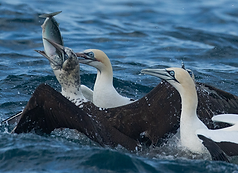
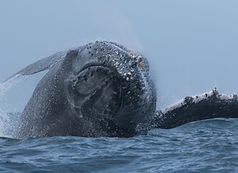
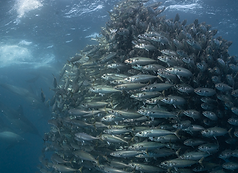
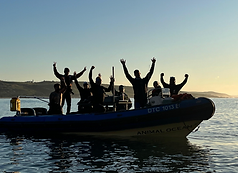
Bait Fish Identification
If you’re joining us on the Sardine Run, you're hoping to witness one of nature’s most spectacular events: the massive shoals of sardines moving north along the coast on their spawning migration. With luck, the action unfolds while we’re on the water, ready and waiting. But sardines aren’t the only baitfish out there. Several species of small, silver fish attract predators during this time — each with its own unique strategy to avoid being eaten. These responses create what we call “baitballs,” though not all baitfish behave the same way.
Saury, for example, don’t form tight schools. They stay near the surface and scatter wildly when chased, triggering scattered dives from Cape gannets and fast, unpredictable lunges by dolphins. This kind of activity is best observed from the boat — there’s no single target for divers.
At the other end of the spectrum are sardines. They form slow-moving, dense bait balls — the ones we’re hoping to find. These fish pack tightly together to reduce individual risk, and when this happens, we can often get in on SCUBA and observe the feeding from the water. Red-eye round herring behave similarly, though their bait balls are looser and more reactive — with larger gaps between fish and a quicker response to predator pressure.
There’s a lot to interpret on the water. Part of what we offer is helping you understand what you're seeing — the species, the behaviours, the dynamics — so you can better appreciate and photograph this remarkable ecosystem.



























